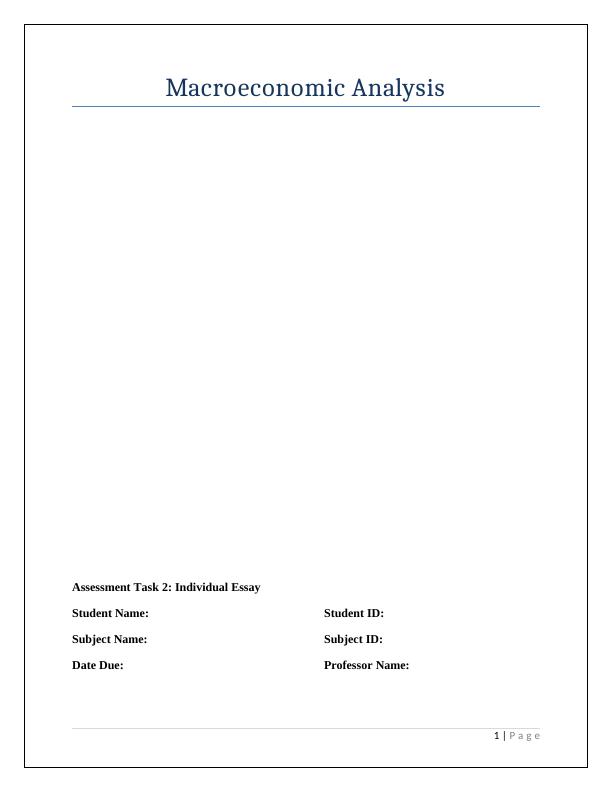Macroeconomic Analysis Assignment
Added on 2021-05-30
9 Pages2055 Words28 Views
Macroeconomic AnalysisAssessment Task 2: Individual EssayStudent Name:Student ID:Subject Name:Subject ID:Date Due:Professor Name:1 | Page

On February 20 this year, the International Monetary Fund (IMF) stated that "wage growth is weak and inflation is below its target range" for the Australian economy. What risks does a slow growth rate in wages pose to the Australian economy, and why are economists and governments so eager to see a general rise in wages for everyone?IntroductionIMF has warned that Australia’s target for wage rate growth is weak with its inflation belowtarget range (Jacobs & Rush, 2015). In the past Australia had experienced dynamic economicperformance attributed to its mining boom from the year 2000s. Recently the country has notbeen able to return to full employment capacities and housing market imbalances. High debt hasposed vulnerabilities within the economy. Bank forecast for wage growth had been strong,however forecast in the variable reflects that there is greater slack in the labor market consideredto anticipated decline in terms of trade. Wage growth has declined surprising even postconsideration of taking multiple factors into account. This implies that wage growth has beenconnected to other determinants which in turn have changed over the past few years, taking intoconsideration cyclical factors that weigh over wage growth. Analysing major drivers of wageoutcomes is essential for understanding labor market conditions and inflationary pressuresexperienced by the Australian economy (Ehrenberg & Smith, 2016). Wages form largest factorwithin business costs, therefore decline in wage growth can be linked to lower rates of inflationoutcomes in future period. The slow rate of wage growth poses several challenges to theAustralian economy hence government is inclined to view general rise in wages for all. Thescope of this analysis deals with several risks that slower rate of wage growth impacts on theeconomy linking across several factors as inflation rates, GDP and so on. Discussion of low wage growth in Australia (using appropriate data)Declining wage rate growth in Australian labor market has been a concern for the FederalGovernment, who is trying to induce several measures to increase wage growths. Macro-economic variables manipulation will lead to only limited changes in the wage growth levels,2 | Page

deeper analysis into structural variables need to be analysed in order to arrive at detailedunderstanding pertaining to the same. Appendix 1. Wage growth is generally measured by meansof wage price index (WPI), but Banks generally incorporates a varied type of measures in orderto assess labor costs by connecting it to various variables of labor market conditions andinflationary pressures within the economy (Davig & Leeper, 2011). Every concept is connectedto different concepts of labor costs with major variables pointing towards slowing of earning inrecent time period. Bank generally adheres to average earnings from the national accounts(AENA) and WPI. WPI index calculates changes in wages for particular period, a quantity oflabor; it is calculated and published by Australian Bureau of Statistics (ABS). The ABSgenerally compares wage from a given previous quarter and then makes adjustments into it byexclusion of any changes is wages that arises from quality of certain work performed. It isgenerally calculated for a defined basket of jobs only and its design need to remain unaffected bycomposition of labor force. AENA is an indicator of inflationary pressures of the economycompared to the WPI as it includes non-wage costs as superannuation, redundancy paymentsmade and calculating impacts of changes to workforce. According to Jacob and Rush (2015)there are various contributors of lower wage growth as spare capacity in the labour market, theneed for the real exchange rate, lower profitability following the decline in the terms of trade anda decline in inflation expectations.Initial; slackness in labor market experienced in Australia since the 2008 have led to employeesaccepting lower wage rates as they were concerned regarding future employment prospects.Wage growth has been restricted by means of declining inflation outcomes and recent year’sexpectations (Hein & Stockhammer, 2010). Employees have been seen to be bargaining over‘real’ wages while comparing some wages to be either indexed or influenced by means of CPIoutcomes. Many scholars attribute sharp fall in trade terms have also had considerable influenceson wage growth in the past period. At the time of run-up in trade terms multiple firms had seen asharp increase in their prices, which help conclude that higher wages could be afforded but therehad been considerable increase in profitability. Considerations of these firms especially miningand mining-exposed had been increasing wages in order to attract higher output. Since 2011firms’ output prices have not been able to grow as quickly which have further contributed toslowing down in wage growth rates. Appendix 2. 3 | Page

End of preview
Want to access all the pages? Upload your documents or become a member.
Related Documents
Economic Policy Frameworks and Markets - PDFlg...
|13
|2327
|237
The risks of slow growth of wage ratelg...
|7
|2013
|89
Economics Policy Framework and Marketlg...
|15
|2105
|20
Comparative Analysis of Australian Economy 2015-2019lg...
|13
|2204
|95
Analysis of Low Real Wage Growth in Australialg...
|7
|1024
|105
Australian economy Assignment PDFlg...
|14
|3921
|154
